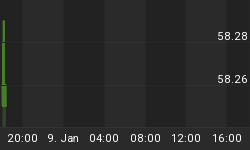In our Charts of the Week video this week, we cover last week's plunge and what the S&P 500 chart looks like, and then we review charts globally, which is the focus of our transcription below. The rest of video covers metals like copper and gold, and individual charts, including AAPL, CREE, F, CLF, INTC, SPG, FCX, AA, and WMT.
You can view the entire video at http://www.mptrader.com/chartsofweek/
While last week's sudden plunge damaged uptrends in many markets, the China market is interesting because it actually peaked in mid-April. It broke its February low on April 27-28 when the S&P 500 was making new highs, and has threatened to turn the whole pattern since mid-2009 from a bullish triangle or coil into a massive top.
The September 2009 low on the Shanghai Composite was 2640, and with Friday's close at 2688 the index bearing is down on that key level. If it breaks you'll have a mature top in place, the projection of which will take it down to 2000, which retrace most of the Oct 08 to August 2009 upleg.
If China is supposed to represent global demand for industrial goods and the procurement of natural resources for the great China build-out, then this massive top is telling me that technically something is not quite right. And this has repercussions for whoever supplies China. If demand is going down in a big way, then sales out of the exporting nations that supply china will take a big hit as well.
One of those countries is Brazil. Looking at the iShares MSCI Brazil Index (EWZ), you see a major top formation that does not look all that dissimilar from the China chart. The EWZ broke the Feb low, though held above it on a rebound, and the chart projects down as low as the 38 area.
Brazil is a natural resource producer that has it all - oil, copper, coffee -- but just like China, which is the great consumer of these things, it has a massive top against a relatively minor bottom. Perhaps the two are related globally, one as a supplier, the other as a buyer. Whatever is the cause, something's going on that is producing the same picture from China in the Shangahi Composite to Brazil in the EWZ, and it's not a friendly growth picture for the globe.
With the natural resource side breaking down, let's look at the consumer side, as represented by Korea, a big producer of high-tech components.
The MSCI South Korea Index (EWY) last week nearly tested its Feb low at 43.84. From a strict technical perspective, the EWY still has a series of higher highs and higher lows. But if it should break the trendline at 43.90 and the prior low, it will have a problem and go into bear phase, the first stop around 35.
That'll be a big decline from its recent high around 53. Moreover, it will mean the consumer side is following the way of the natural resource side.
For now, however, with the employment situation in the U.S. getting better, the consumer is hanging in there and so is Korean market, unless it breaks these levels.
Germany's chart is not as encouraging. The MSCI Germany Index (EWG) had a low if February of 19 1/4, which was broken Thursday on the plunge to 18.77 and did not have much of a recovery on Friday, with a close of 19.17. Once again we find a chart that is sort of a big double top, if not just a big top.
It's obvious that the burden of being Europe's financier at a time when so many countries are coming hat in hand and asking for help is potentially weighing on the German market.
It's yet another topping chart, albeit for different reasons, but a top nonetheless, in addition to China, Brazil and possibly Korea.
These charts have implications for the U.S. market, of course, which looks the best. But for how long? The S&P 500 hasn't yet broken the February low, even with the downleg intact, and so as long as it holds the 1044 area, the bull market is still intact.
But it's worth watching these other markets, particularly Korea, which hasn't yet broken, for signs of where our own market is heading.
You can view the entire video at http://www.mptrader.com/chartsofweek/
















